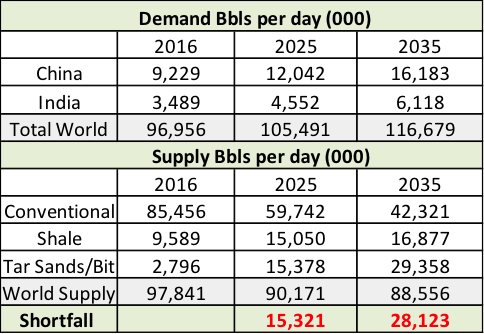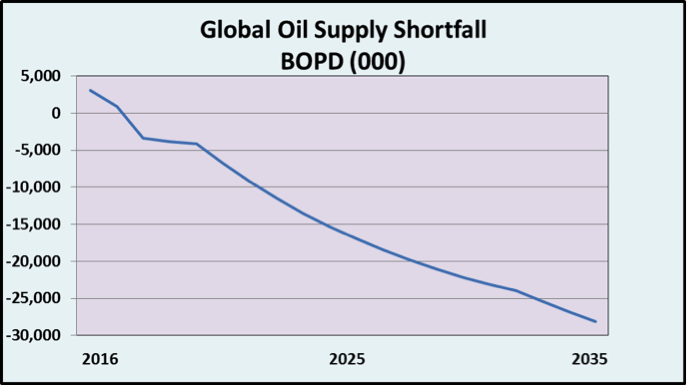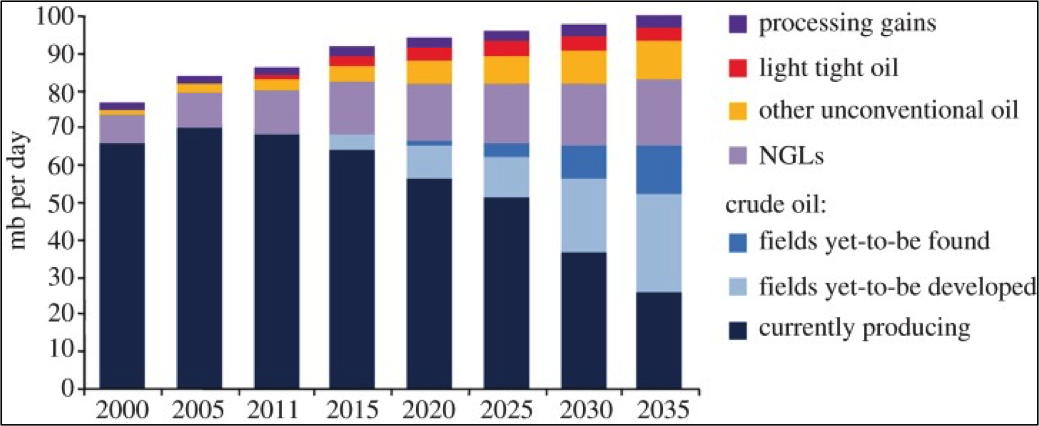|
FRIDAY EDITION May 9th, 2025 |
|
Home :: Archives :: Contact |
 |

Possible Global Oil Industry Disruption
By Kenneth J. Gerbino As a starting point, an analysis on the future price of oil should remind the pundits and investment community of a few important facts:
Supply and Demand Facts From the demand side, the world demand for oil has averaged about 1.3% increase per year since 2002, with China and India showing average annual demand growth between 5.5% for India and 6-8% per year for China from 2002 to 2012. Global demand as of the 4th quarter of 2015 was approx. 96 million bbls a day according to the IEA and global supply was 97.2 million bbls daily. This is the current state of the over-supply of oil and demand. Hence the low oil price hovering below $40. This analysis calculates just modest increases in demand, historic industry data on typical oil field production declines and the 50-year average of ultimate oil recovery from oil fields (per cent recovered of the original oil in place). Then the possible supply from shale oil and tar sands is added to supply and a possible trend for supply and demand can be established. The calculation of future supply and demand with the very conservative caveats listed below leads me to a radical conclusion that I believe is not being addressed by industry or governments. Here are some simple data points showing the experts projections and the changes used in my model going out 10 and 20 years.
New discoveries (18 billion bbls a year on average) will be produced over a typical 20-year period. Only 35% of this discovered oil will be produced. To this day, the industry leaves 65% of the oil in existing oil fields. It is trapped oil. Halliburton estimates there is 6.2 trillion (T) barrels of oil trapped in existing global oil fields. Therefore, these new annual discoveries will yield 6.3 billion bbls to be recovered over the life of these fields. The Bottom Line The bottom line of the above factors calculates and looks very disturbing. 

Needless to say, a possible 15-28 million bbls of oil shortfall a day in the next 10-20 years is without a doubt a troubling thought. This would create an oil price spike that is uncalculable. It would create geo-political and economic stress that would affect all countries. Exploration budgets have been slashed dramatically all over the world. In the United States, Oil and Gas Journal (March 7, 2016) reports that $72 billion was slashed from the 2015 budgets, a 37% reduction from 2014 and in 2016 the reduction is $49 billion or a further 25% reduction from 2015. As stated earlier, these reductions in the U.S. and in other countries will affect the supply chain well into the future. The most disturbing graph is this one published by the International Energy Agency. 
As you can see the dark blue bottom portion of the bars is showing existing production declining from about 62 million bbls a day in 2015 to 25 million bbls a day in 2035. More disturbing is the hoped for lighter blue sections that are projected to deliver almost 40 million bbls of oil from oil fields not found yet or that have not been developed. NGL stands for Natural Gas Liquids which are included as part of the oil equation in what is refered to as boe (barrel of oil equivalents). Notice how small the light tight oil section is. This is the new name for shale oil. I would be thrilled if 50% of this 40 million bbls actually comes on stream. As you can see the IEA is predicting a supply of 100 million barrels of oil equivalent per day in 2035. Remember the demand figures I stated earlier where I reduced demand dramatically from where the experts and the current levels actually are? Those dramatic reductions in demand show a 2035 demand for oil of almost 117 million barrels of oil per day. Can Shale Oil Save the Day? Shale oil production is expensive and production declines are usually 80% the first two years. So to produce lets say 15 million bbls a day of shale oil at a steady pace would require about $6-7 trillion of investment over a 20 year period. Shale oil is in reservoir rock 1,000 to 10,000 times denser than normal oil field rock. Operators will at best only recover about 10% of the oil resource. To understand shale oil extraction, think of taking some olive oil and pouring it on a piece of bread. That would show you the permiability of the oil flowing through the bread. Now take a hammer and crack your kitchen counter, (assuming it is a made from granite or marble). The density of that counter is about 500 times denser than the bread. So the only oil that would escape from that counter top rock (we are assuming there would be some oil there for illustration purposes) would be the oil right next to the cracks in the counter. This simple example above is what “fracking” is all about. Making a lot of cracks in the very dense shale rock. If they only get 35% of the oil from sandstone it is a big stretch to get anything near 10% from shale which is thousands of times denser. Conclusion Iraq and Iran coming back on stream won't make much of a difference as the conventional oil fields including all the oil fields in the mid-east, collectively are also losing 6% of production every year due to normal production declines. Globally, 5 years from today 20-25 million bbls of daily oil production from existing oil fields will not be there. That is a huge amount oil to replace with Iran, Iraq, shale, tar sands and new discoveries. The repurcussions of this exercise are not hard to imagine. New technology will be needed to recover more oil and at lower costs than the industry is capable of today. The Good News There is good news to this unfortunate yet realistic article. The good news is that there are 6.2 trillion barrels of trapped oil in existing oil fields. Recovering just a small percent of this trapped oil could save the day. There is now new techology to extract this trapped oil. It will be this technology that will have a very positive effect on what appears to be a very dismal supply/demand situation in our future.  Archives
|
| Home :: Archives :: Contact |
FRIDAY EDITION May 9th, 2025 © 2025 321energy.com |
|